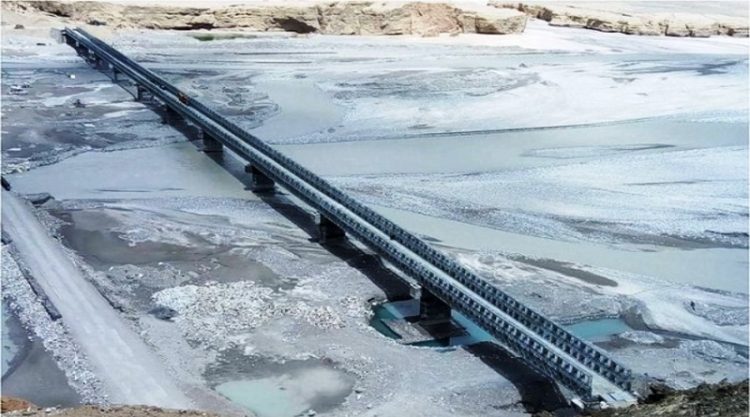Defence Minister Rajnath Singh along with Army Chief Bipin Rawat would inaugurate a strategic bridge on the Shyok River in the Ladakh region on Monday, 21st October 2019.
This bridge is named after the legendary Indian Army officer Colonel Chewang Rinchen, fondly remembered as the “Lion of Ladakh”.
The inauguration ceremony would be attended by the family of Colonel Rinchen including his daughter Dr Angmo and his granddaughter. His ancestral home in Sumur village was converted to a heritage site.
All About The Strategic Bridge
The 1,400 feet long bridge situated at the height of 14,650 feet has been constructed by the Border Road Organisation (BRO) within a period of just 15 months. Situated on the road connecting Leh’s Darbuk to Daulat Beg Oldi, it is expected to reduce travel time by half an hour.
It is part of a larger 255 km road span which encompasses 37 bridges across various streams and rivers. The bridge is situated 45 km to the east of the Line of Actual Control (LAC) bordering China’s Xinjiang province.
Apart from ensuring quicker troop movement, it is expected to help in the development of border villages.
The 4.5-metre wide bridge has been designed to support 70-tonne class vehicles. This means that the bridge is expected to facilitate the movement of Indian battle tanks like the T-90 which weigh 48 tonnes and are 3.5 metres wide.
Colonel Chewang Rinchen – The Lion Of Ladakh
The bridge has been named after the legendary Colonel Chewang Rinchen who is India’s youngest ever recipient of the Maha Vir Chakra – which he was awarded for heroics at the age of just 17.
In 1948, when Pakistan’s tribal raiders captured Kargil and set their eyes on Leh, Ladakh was being defended by just 33 men of the Jammu and Kashmir state forces and 20 volunteers led by Lieutenant Colonel Prithi Singh.
When Lt Col Prithi Singh raised the tricolour in Leh and sought volunteers to defend Ladakh against Pakistani raiders, 17-year-old Chewang Rinchen from the Nubra Valley was the first to respond to protect his motherland.
The young Rinchen underwent a quick training and then went on to recruit 28 of his friends from the Nubra Valley to create the Nubra Volunteer Force. This force then evolved to become the famed Ladakh scouts.
During the war, he and his men went on to play a crucial role which included marching for three days over high snowdrifts despite suffering from frostbite. Colonel Rinchen and his men were involved in a fierce hill battle near Biagdangdo, which they successfully captured.
For his bravery and leadership, he was awarded India’s second-highest military honour the Maha Vir Chakra in 1952.
In the 1971 India-Pakistan war, Colonel Rinchen freed nine enemy points located in Ladakh’s Partapur sector. For his heroics, he was again awarded the Maha Vir Chakra.
The Strategic Importance Of Ladakh
Ladakh is critical for maintaining Indian presence on the Siachen Glacier as it provides physical approach to the frozen battlefield, connecting to the rest of the country.
West of the Siachen glacier, across the Saltoro Ridge, lies Pakistan-occupied Gilgit and Baltistan. East of it lies China-occupied Aksai Chin. With a presence on the Siachen glacier, India has managed to prevent China and Pakistan from linking up.
Also crucially, India shares a disputed border with China in Ladakh which regularly sees transgressions by the People’s Liberation Army (PLA). Just days ahead of Chinese President Xi Jinping’s first visit to India in 2014, the PLA camped kilometres inside Indian territory in the Chumar sector.














Discussion about this post